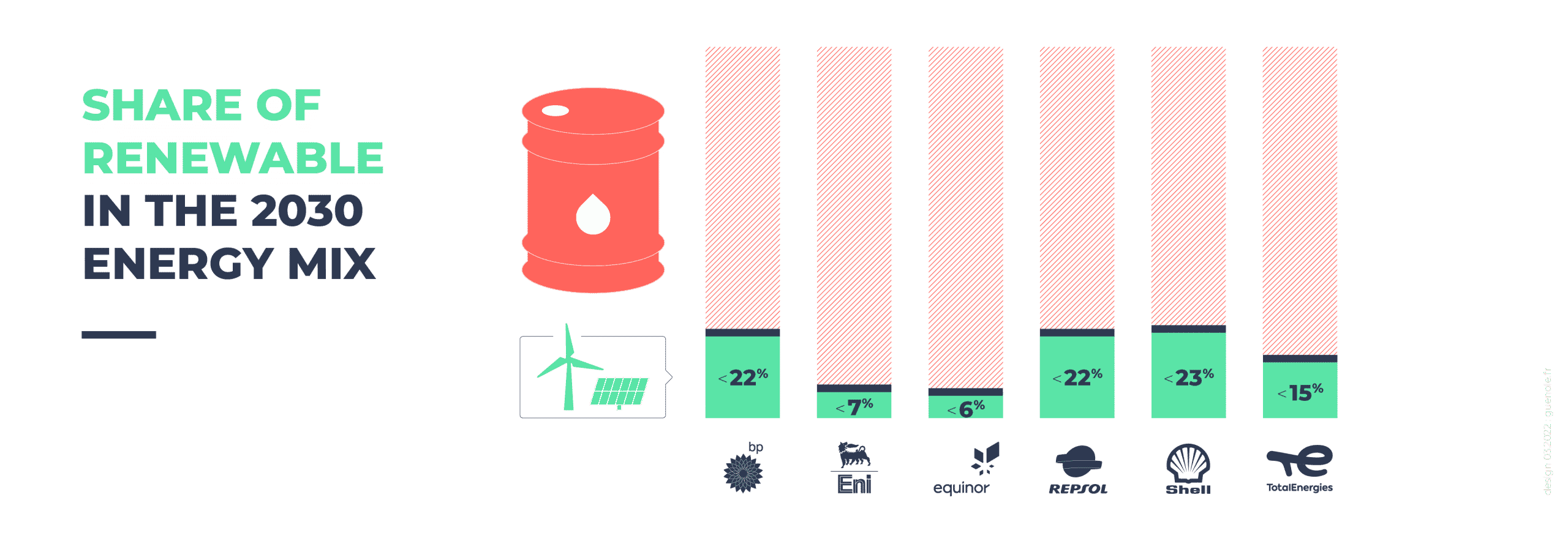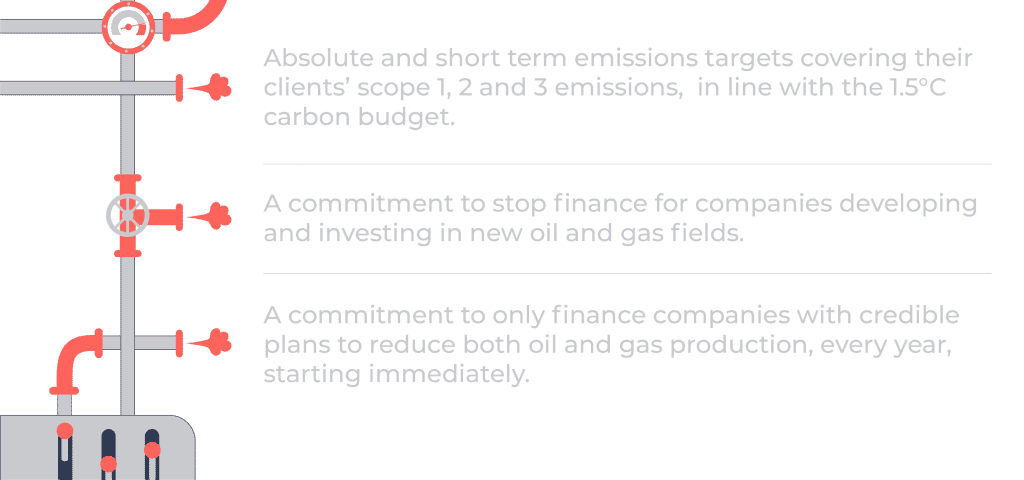Shell, TotalEnergies, BP, Eni, Equinor and Repsol are the six biggest European oil and gas producers. All of them claim to have a credible plan to achieve their net-zero ambitions by 2050. These promises resonate with banks, insurers and investors who seek to support so-called “best in class” and “climate-aligned” companies.
But a new analysis from Reclaim Finance reveals that given their current business strategies and weak climate targets, the six “majors” of the European oil and gas industry are not on track to reduce their GHG emissions and will largely overshoot the remaining 1.5°C carbon budget.






A DANGEROUS CARBON BUDGET OVERSHOOT
Committing to distant carbon neutrality targets is not enough to keep global warming below 1.5°C. The pathway to net-zero matters much more than the final destination and none of the majors are currently following the right path.
Given that in the short and medium term, the companies remain heavily focused on hydrocarbon production, greenhouse gas emissions will quickly accumulate. Reclaim calculations, based on the six companies’ own projections and data, reveal that by 2038 at the latest, all six companies will have used up their entire carbon budget to stay below 1.5°C. By 2050, their carbon budget overshoot spans from 13.6 to 78.7%.
…
2020
2030
2050
…

+50.9%

+13.6%

+25.6%

+78.7%

+40.9%

+31.8%
The six majors will overshoot their 1.5°C carbon budget by 2038 at the latest.

To meet their emission targets, the oil and gas companies need to drastically curb oil and gas production and transition to renewable energy, but that is not what they are doing. According to Reclaim Finance’s findings, oil and production levels remain very high, and at least three majors – ENI, Equinor and Total Energies – plan to increase production levels by 2030, compared with 2016 levels. And the future is not looking much brighter: unless the companies commit to stop developing new oil and gas projects in the near future, production levels will remain too high to align with 1.5°C and will vastly overshadow renewable energy production. In 2030, company data shows that renewable energy will account for less than a quarter of each major’s energy mix.
TotalEnergies’ projections show the most worrying trend. In 2030, TotalEnergies plans to produce 47% more oil and gas production than in 2015, when nations across the world adopted the Paris Climate Agreement. Not only does this dwarf the major’s efforts to increase renewable energy production, it is incompatible with what climate science requires. According to the United Nations 2021 Production Gap Report, global oil and gas production must start declining by 4% and 3% respectively each year over this decade to stay below 1.5°C.
The recent decision by some of the majors to walk away from their Russian operations could help drastically reduce their fossil fuel production levels. Will they decide to align with 1.5°C or simply replace these operations with more oil and gas production elsewhere?
INVESTING IN AN OIL & GAS FUTURE
In 2021, the International Energy Agency (IEA), the world’s most influential source of energy projections, released a net-zero scenario and drew a red line: oil and gas expansion must stop now in order to limit global warming to +1.5°C. This means that there is no room left in our carbon budget beyond 2021 to develop and invest in new oil and gas fields.
Yet, all six European majors are currently developing new oil and gas projects. They also hold many more reserves that could enter into production at a later stage, and are even investing in exploration, looking to discover even more reserves. None of this new oil and gas is compatible with a 1.5°C future.
MAJORS ARE ALLOCATING 60% TO 90% OF THEIR INVESTMENTS TO OIL AND GAS
Despite being very vocal about its growing investments in renewable energy, the European oil and gas industry dedicates only a small part of their investment to renewables. In the short term, the six European oil and gas majors plan to spend 60% to 90% of their investment capacity in oil and gas. As illustrated above, these investments made today will have longer term consequences on the energy mix.
THE MAJORS DO NOT HAVE CREDIBLE CLIMATE PLANS

BP is the 3rd biggest European oil and gas developer and the 10th largest globally. Oil and gas will still make up 73% of the company’s investments in the near term and in 2030, renewables will represent less than 25% of its energy mix. Even though the company has pledged to reach carbon neutrality in 2050, by then, BP will have emitted 51% more GHG than its share of the remaining 1.5°C carbon budget. The overshoot will start as soon as 2033, if not earlier. Click here for more

ENI’s current strategy is incompatible with 1.5°C.
ENI is the 5th biggest European oil and gas developer and the 19th largest globally. Oil and gas will still make up 78% of the company’s investments in the near term and in 2030, renewables will represent less than 10% of its energy mix. Even though the company has pledged to reach carbon neutrality in 2050, by then, ENI will have emitted 13.6% more GHG than its share of the remaining carbon budget to limit global warming to 1.5°C. The overshoot will start in 2038, if not earlier. Click here for more

Equinor’s current strategy is incompatible with 1.5°C.
Equinor is the 4th biggest European oil and gas developer and the 13th largest globally. Oil and gas will still make up 83% of the company’s investments in the near term and in 2030, renewables will represent less than 10% of its energy mix. Even though the company has pledged to reach carbon neutrality in 2050, by then, Equinor will have emitted about 25.6% more GHG than its share of the remaining carbon budget to limit global warming to 1.5°C. The overshoot will start as soon as 2037, if not earlier.

Repsol’s current strategy is incompatible with 1.5°C.
Repsol is the 7th biggest European oil and gas developer and the 61st largest globally. Oil and gas will still make up 65% of the company’s investments in the near term and in 2030 renewables will represent less than 25% of its energy mix. Even though the company has pledged to reach carbon neutrality in 2050, by then, Repsol will have emitted 78.7% more GHG than its share of the remaining carbon budget to limit global warming to 1.5°C. The overshoot will start as soon as 2033, if not earlier.

Shell’s current strategy is incompatible with 1.5°C.
Shell is the 2nd biggest European oil and gas developer and the 9th largest globally. Oil and gas will still make up 89% of the company’s investments in the near term and in 2030 renewables will represent less than 25% of its energy mix. Even though the company has pledged to reach carbon neutrality in 2050, by then, Shell will have emitted 41% more GHG than its share of the remaining carbon budget to limit global warming to 1.5°C. The overshoot will start as soon as 2034, if not earlier. Click here for more

TotalEnergies' current strategy is incompatible with 1.5°C.
TotalEnergies is the top European oil and gas developer and the 7th largest globally. Oil and gas will still make up 75% of the company’s investments in the near term and in 2030, renewables will represent less than 15% of the energy mix. Even though the company has pledged to reach carbon neutrality in 2050, by then, TotalEnergies will have emitted 31.8% more GHG than its share of the remaining carbon budget to limit global warming to 1.5°C. The overshoot will start as soon as 2035, if not earlier. Click here for more
THE KEYS TO A CREDIBLE NET-ZERO PLAN
More than 450 banks, insurers and investors worldwide have joined one or more of the alliances and initiatives that make up the Glasgow Financial Alliance for Net Zero (GFANZ). All the GFANZ members have pledged to reach net zero emissions from their clients by 2050, and to halve emissions by 2030. To meet these commitments, financial institutions will need to take drastic and rapid action to stop fossil fuel expansion and then reduce production. Financial institutions must draw up clear redlines and expectations for the oil and gas industry, to ensure oil and gas majors are aligned with global climate goals.





